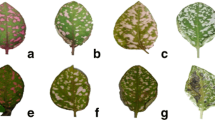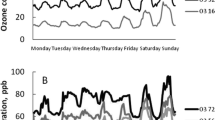Summary
Impacts of increasing tropospheric ozone, together with the most important interactive stress factors (such as drought, soil N, and early frost) on European white birch (Betula pendula Roth) has been extensively investigated. In this paper, a summary of those studies, conducted both in chambers and realistic open-field conditions, is presented. Typical ozone responses in birch were found as impaired foliage, stem and root growth, altered shoot to root ratio, delayed bud burst, visible foliar injuries, enhanced leaf senescence, disturbed stomatal conductance, impaired net photosynthesis and water-use efficiency, reduced concentrations of Rubisco, pigments, starch, soluble protein and nitrogen, increased concentrations of phenolic compounds, increased transcription levels of genes encoding stress proteins PR-10 and PAL, increased stomatal density, reduced leaf thickness, ultrastructural injuries in chloroplasts and mitochondria, increased mesophyll cell wall thickness and reduced volume for intercellular space. Many of the negative responses were significantly promoted by simultaneous soil drought or early frost. Although elevated soil N counteracted ozone-caused growth reductions, delayed leaf senescence and increased shoot to root ratio may lead to disturbances in winter hardening processes and predispose the trees e.g. to soil drought due to a lower water uptake per higher water loss through transpiration.
Access this chapter
Tax calculation will be finalised at checkout
Purchases are for personal use only
Preview
Unable to display preview. Download preview PDF.
Similar content being viewed by others
References
De Temmerman L, Vandermeiren K, D’Haese D, Bortier K, Asard H, Ceulemans R (2002) Ozone effects on trees, where uptake and detoxification meet. Dendrobiology 47:9–19
Executive Report 2002. The Condition of Forests in Europe. United Nations Economic Commission for Europe, European Commission, Germany, ISSN 1020-587X, 35 p
Karlsson PE, Uddling J, Braun S, Broadmeadow M, Elvira S, Gimeno BS, Le Thiec D, Oksanen E, Vandermeiren K, Wilkinson M, Emberson L (2004) New critical levels for ozone effects on young trees based on AOT40 and simulated cumulative leaf uptake of ozone. Atm Env 38:2283–2294
Oksanen E (2001) Increasing tropospheric ozone level reduced birch (Betula pendula) dry mass within five years period. Water Air Soil Pollut 130:947–952
Oksanen E (2003a) Physiological ozone responses of birch (Betula pendula Roth) differ between soil-grown trees in a multi-year exposure and potted saplings in a single-season exposure. Tree Physiol 23:603–614
Oksanen E (2003b) Responses of selected birch (Betula pendula) clones to ozone change over time. Plant Cell Environ 26:875–886
Oksanen E, Holopainen T (2001) Responses of two birch (Betula pendula Roth) clones to different ozone profiles with similar AOT40 exposure. Atmos Environ 35:5245–5254
Oksanen E, Rousi M (2001) Differences in Betula origins in ozone sensitivity based open-field fumigation experiment over two growing seasons. Can J For Res 31:804–811
Oksanen E, Saleem A (1999) Ozone exposure results in various carry-over effects and prolonged reduction in biomass in birch (Betula pendula Roth). Plant Cell Environ 22:1401–1411
Pääkkönen E, Holopainen T (1995) Influence of nitrogen supply on the response of birch (Betula pendula Roth.) clones to ozone. New Phytol 129:595–603
Pääkkönen E, Paasisalo S, Holopainen T, Kärenlampi L (1993) Growth and stomatal responses of birch (Betula pendula Roth.) clones to ozone in open-air and chamber fumigations. New Phytol 125:615–623
Pääkkönen E, Holopainen T, Kärenlampi L (1995a) Ageing-related anatomical and ultra-structural changes in leaves of birch (Betula pendula Roth.) clones as affected by low ozone exposure. Ann Bot 75:285–294
Pääkkönen E, Metsärinne S, Holopainen T, Kärenlampi L (1995b) The ozone sensitivity of birch (Betula pendula) in relation to the developmental stage of leaves. New Phytol 132:145–154
Pääkkönen E, Vahala J, Holopainen T, Karjalainen R, Kärenlampi L (1996) Growth responses and related biochemical and ultrastructural changes of the photosynthetic machinery in birch (Betula pendula Roth.) exposed to low level ozone fumigation. Tree Physiol 16:597–605
Pääkkönen E, Vahala J, Pohjola M, Holopainen T, Kärenlampi L (1998a) Physiological, stomatal and ultrastructural ozone responses in birch (Betula pendula Roth) are modified by water stress. Plant Cell Environ 21:671–684
Pääkkönen E, Günthardt-Goerg M, Holopainen T (1998b) Responses of leaf processes in a sensitive birch (Betula pendula Roth) clone to ozone combined with drought. Ann Bot 82:49–59
Pääkkönen E, Seppänen S, Holopainen T, Kärenlampi S, Kärenlampi L, Kangasjärvi J (1998c) Induction of genes for the stress proteins PR-10 and PAL in relation to growth, visible injuries and stomatal responses in ozone and drought exposed birch (Betula pendula) clones. New Phytol 138:295–305
Prozherina N, Freiwald V, Rousi M, Oksanen E (2003) Effect of spring-time frost and elevated ozone on early growth, foliar injuries and leaf structure of birch (Betula pendula Roth) genotypes. New Phytol 159:623–636
Root TJ, Price JT, Hall KR, Schneider SH, Rosenzweig C, Pounds JA (2003) Fingerprints of global warming on wild animals and plants. Nature 421: 57–60
Saleem A, Loponen J, Pihlaja K, Oksanen E (2001) Effects of long-term open-field ozone exposure on leaf phenolics of European silver birch (Betula pendula Roth). J Chem Ecol 27:1049–1062
Uddling J, Günthard-Goerg MS, Matyssek R, Oksanen E, Pleijel H, Selldén G, Karlsson PE (2004) Biomass reductions of juvenile birch were more strongly related to stomatal uptake of ozone than to ozone indices based on external exposure. Atmos Environ 38:4709–4719
Yamaji K, Julkunen-Tiitto R, Rousi M, Freiwald V, Oksanen E (2003) Ozone exposure over two growing seasons alters root to shoot ratio and chemical composition of birch (Betula pendula Roth). Glob Change Biol 9:1363–1377
Author information
Authors and Affiliations
Editor information
Editors and Affiliations
Rights and permissions
Copyright information
© 2005 Springer-Verlag Tokyo
About this paper
Cite this paper
Oksanen, E. (2005). Northern conditions enhance the susceptibility of birch (Betula pendula Roth) to oxidative stress caused by ozone. In: Omasa, K., Nouchi, I., De Kok, L.J. (eds) Plant Responses to Air Pollution and Global Change. Springer, Tokyo. https://doi.org/10.1007/4-431-31014-2_4
Download citation
DOI: https://doi.org/10.1007/4-431-31014-2_4
Publisher Name: Springer, Tokyo
Print ISBN: 978-4-431-31013-6
Online ISBN: 978-4-431-31014-3
eBook Packages: Biomedical and Life SciencesBiomedical and Life Sciences (R0)




